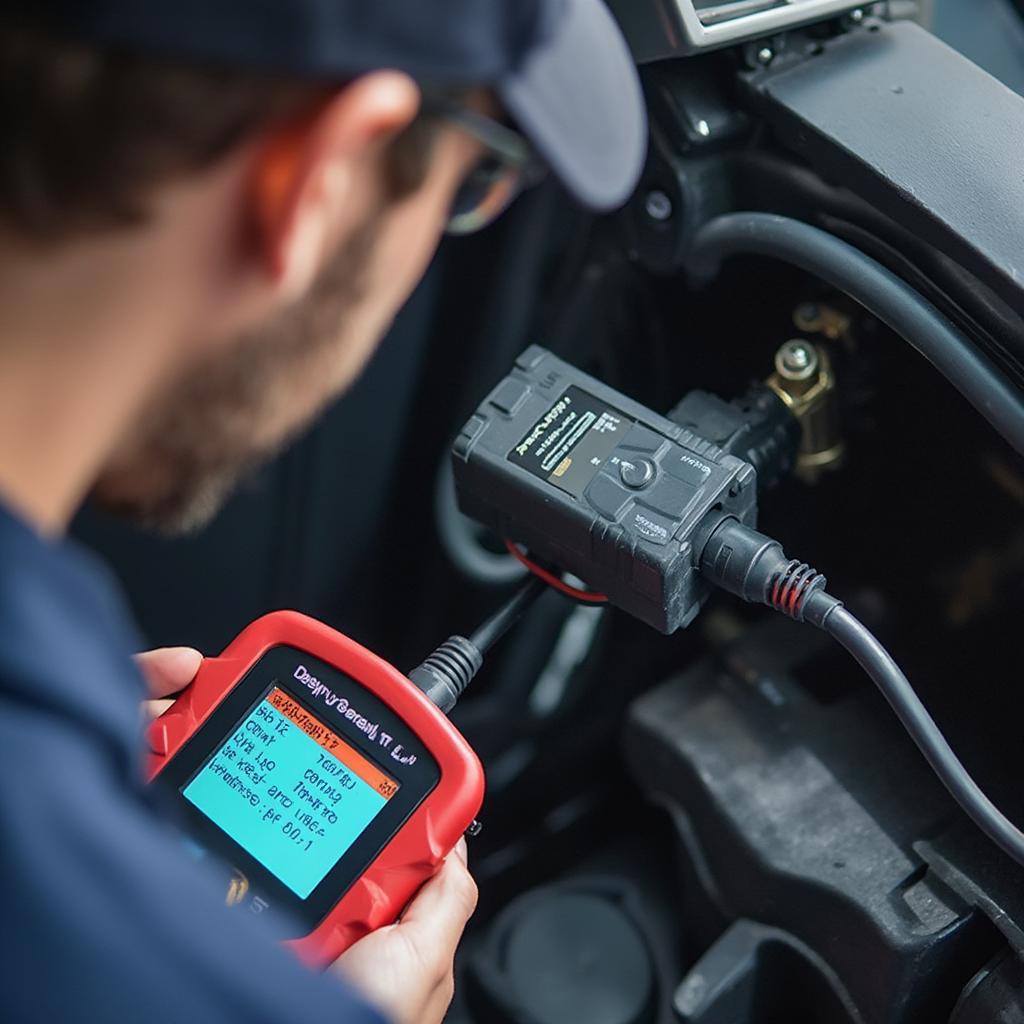Bidirectional OBD2 scanners, also known as bidirectional scan tools, represent a significant advancement in automotive diagnostics. These powerful tools go beyond simply reading diagnostic trouble codes (DTCs) and allow mechanics and technicians to interact with a vehicle’s electronic control units (ECUs) in a much more comprehensive way. This means you can not only identify what’s wrong but also test components and systems to pinpoint the exact cause of a problem.
Traditional OBD2 scanners primarily retrieve information from a vehicle’s ECUs, such as DTCs, freeze frame data, and live sensor readings. Bidirectional OBD2 scanners, on the other hand, take this a step further by enabling users to send commands to the ECUs. This capability opens up a wide range of diagnostic and troubleshooting possibilities, making them an indispensable tool for professional mechanics.
Understanding the Power of Bidirectional Control
The core advantage of a bidirectional OBD2 scanner lies in its ability to perform active tests. Instead of passively reading data, you can actively command various vehicle systems to operate. For instance, you can instruct the fuel pump to turn on, cycle the ABS solenoids, or even activate the cooling fan. This allows you to isolate faulty components and verify repairs without relying solely on guesswork.
With a bidirectional scanner, you can perform tasks such as:
- Activating relays and solenoids
- Controlling actuators and motors
- Testing individual components in a system
- Simulating sensor inputs
- Performing system calibrations
This level of control allows for faster and more accurate diagnoses, saving both time and money in the repair process.
Autel Maxicheck MX808s OBD2 Scanner Full Bidirectional Diagnostic Scan Tool
Why Choose a Bidirectional OBD2 Scanner?
Beyond their diagnostic capabilities, bidirectional OBD2 scanners offer a number of other benefits:
- Reduced Diagnostic Time: By actively testing components, you can quickly pinpoint the source of a problem, eliminating the need for lengthy trial-and-error processes.
- Improved Accuracy: Bidirectional control allows you to verify the effectiveness of repairs and ensure the system is functioning correctly.
- Enhanced Troubleshooting: The ability to interact with various systems provides a deeper understanding of how they operate, enabling more effective troubleshooting.
- Cost Savings: By accurately diagnosing and repairing issues, you can avoid unnecessary part replacements and labor costs.
What to Look for in a Bidirectional OBD2 Scanner
When choosing a bidirectional OBD2 scanner, consider these key factors:
- Vehicle Compatibility: Ensure the scanner supports the makes and models you work with.
- Software and Updates: Regular software updates are crucial for maintaining compatibility with new vehicle systems.
- Features and Functions: Consider the specific functions you require, such as coding, programming, and special functions.
- Ease of Use: The scanner should be intuitive and user-friendly, with a clear display and easy-to-navigate menus.
- Durability and Build Quality: Opt for a scanner that is built to withstand the rigors of a professional workshop environment.
Bidirectional OBD2 Scanners: A Valuable Investment
While traditional OBD2 scanners are useful for basic diagnostics, bidirectional scanners offer a level of functionality that is essential for professional mechanics and technicians. The ability to actively control and test vehicle systems allows for more efficient and accurate diagnostics, ultimately leading to faster repairs and satisfied customers. Investing in a quality bidirectional OBD2 scanner is a smart choice for any serious automotive professional.
Bidirectional activation capability OBD2 scanner
“A bidirectional scanner is like having a conversation with the car. You’re not just listening; you’re actively engaging and getting a much clearer picture of what’s going on,” says John Smith, ASE Certified Master Technician.
Conclusion
Bidirectional OBD2 scanners are invaluable tools for today’s automotive professionals. They allow for a deeper level of interaction with vehicle systems, leading to faster and more accurate diagnoses. By understanding what bidirectional OBD2 scanners are and how they function, you can make informed decisions about incorporating this technology into your diagnostic toolkit.
Good bidirectional OBD2 and CAN scanner
FAQ
- What is the difference between a unidirectional and a bidirectional OBD2 scanner?
- Can a bidirectional scanner damage a vehicle’s ECU?
- What are some common uses for a bidirectional scanner?
- Do all bidirectional scanners offer the same functionalities?
- How much does a bidirectional OBD2 scanner typically cost?
- Are there any special training requirements for using a bidirectional scanner?
- Can bidirectional scanners be used on all vehicle makes and models?
“Investing in a bidirectional scanner is an investment in your business. It saves time, reduces diagnostic errors, and ultimately improves customer satisfaction,” adds Jane Doe, Automotive Electrical Systems Specialist.
Common Scenarios:
- Scenario 1: Intermittent Check Engine Light – A bidirectional scanner can activate individual components in the suspected system to pinpoint the fault.
- Scenario 2: Faulty Actuator – Test the actuator’s response to commands from the scanner to confirm its operation.
- Scenario 3: Post-Repair Verification – Ensure the repaired system is functioning correctly by actively testing its components.
Further Exploration:
- Thinkdiag OBD2 Scanner Bluetooth iOS&Android Bidirectional Scan Tool
- OBD2 bidirectional scanner Volvo
For further assistance, contact us via WhatsApp: +1(641)206-8880, Email: [email protected] or visit us at 789 Elm Street, San Francisco, CA 94102, USA. Our customer support team is available 24/7.


